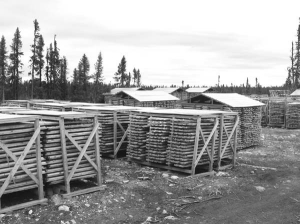An updated scoping study for Strateco Resources’ (RSC-T, SRSIF-O) Matoush uranium project in Quebec’s Otish mountains shows stronger economics, lower costs and higher production, but the US$75 per lb. uranium oxide price used in the study could make those numbers seem slightly inflated, at least for now.
Spot uranium has fallen from its dramatic rise above US$130 per lb. in 2007 to about US$42 today and Strateco president and CEO Guy Hbert says this hasn’t made things easy.
“It’s pretty hard for uranium companies right now because of the spot price,” Hbert says. “It’s very depressed; it’s been going down almost every day for the last five weeks.”
But Hbert says he isn’t worried, adding that few transactions are done using the spot price; instead a long-term price, currently around US$62 per lb., is used.
On top of that, if the company is able to bring the Matoush project into production, it won’t happen until late 2013 or 2014.
Strateco’s timing is actually good, Hebert says, noting that nuclear reactors are under construction in China and that United States’ President Barack Obama has recently earmarked more than $50 billion in federal loans to help build new nuclear power plants there.
“I think the uranium future is very, very bright but the market is not very patient,” Hebert says. “It’s a good time for people to invest in uranium stocks. Eventually, it will come back.”
According to this latest study, Strateco would produce 2-2.7 million lbs. of U308 per year over seven years for a total of 17.8 million lbs. — about 2 million lbs. more than the earlier study.
Development costs were basically unchanged; the project would cost $292.8 million plus another $19 million in sustaining capital and $30 million in closure costs for a total of $341 million.
The internal rate of return before taxes is 41.5%, up from 37.1%, while the net present value is $377.6 million (with an 8% discount rate) compared to US$271.2 million in the earlier study.
Operating costs are US$3.57 per lb. lower at US$23.66 per lb.
Although Quebec is famous in the mining industry for its cheap hydro power, the isolated location in the Otish basin means that bringing in a power line would be too expensive. “We are talking $150 million with the power line,” Hbert says.
Instead the company is looking into the use of two windmills to produce electricity to offset the cost of fuel for the generator.
“It’s very windy and we expect to get a 45-50% savings on fuel, if we are lucky,” Hbert says. “They would cost $7-10 million each, but you save that within two years on fuel.”
Hbert says there’s a good chance that the $30-million closure costs will also be lower. The scoping study also looked at a $10-million option. “Maybe we’ll be in between at $15 million or $20 million; $30 million is extreme.”
Recently, Strateco has started an aggressive drill program to expand resources over the next two years.
Resources were last updated in September 2009. Indicated resources stand at 436,000 tonnes grading 0.78% U308 for contained uranium oxide of 7.46 million lbs., using a cutoff grade of 0.10% uranium oxide.
The inferred resource is estimated at 1.16 million tonnes grading 0.50% U308 for 12.78 million lbs. of U308.
The company plans to drill 120,000 metres. The idea was to drill a 400-metre-deep hole every 200 metres for the last 12 km of the known Matoush mineralization, but the company had some luck pretty early.
“We found a new area about 1.5 kilometres from the main lens which is about 600 metres long,” Hbert says.
The zone is showing good continuity, he says, so the company is using one of the three drill rigs to concentrate on the new zone.
The company is waiting to get a licence to develop a ramp underground. Hebert says that once the company is able to explore underground, the mining dilution for the ore could improve.
For the scoping study, Strateco used 15% at zero value because it didn’t “know the quality of the underground around the fault,” Hebert explains. “It’s better to use higher figures here.”
Once the company gets the underground exploration licence, it will increase staff at the camp to 90 people from 50.
Over the winter, the company has had dozens of truckloads of supplies and equipment for the underground along the 140-km winter road from the Chibougamau area.
Aside from the winter road, the project is only accessible via float plane. However, Strateco is building a ground airstrip to improve access and cut down costs. Operating is costly during the fall and spring when the lake is freezing or thawing because the company is restricted to using helicopters to access the project site.


Be the first to comment on "Strateco Positive About Uranium"